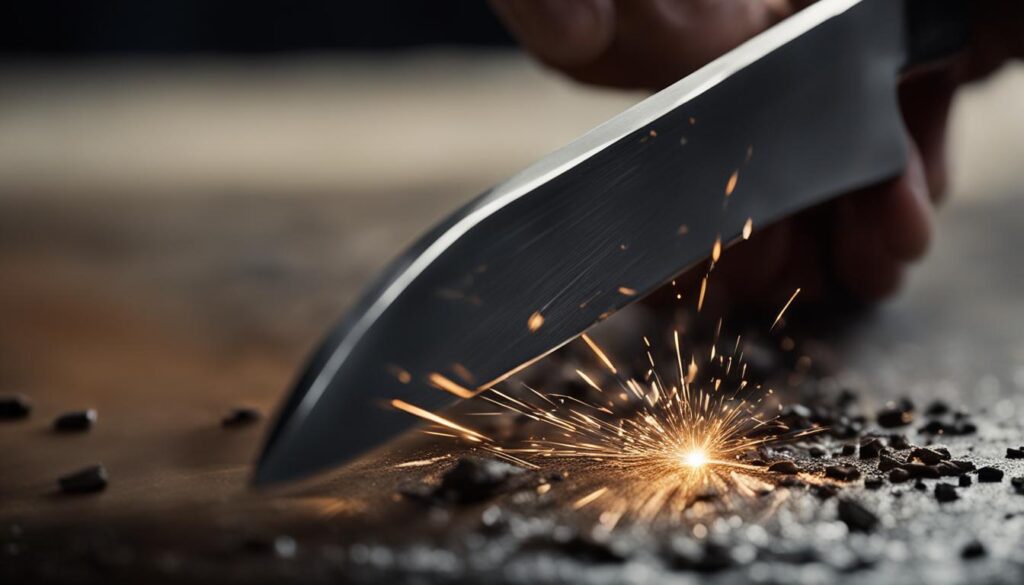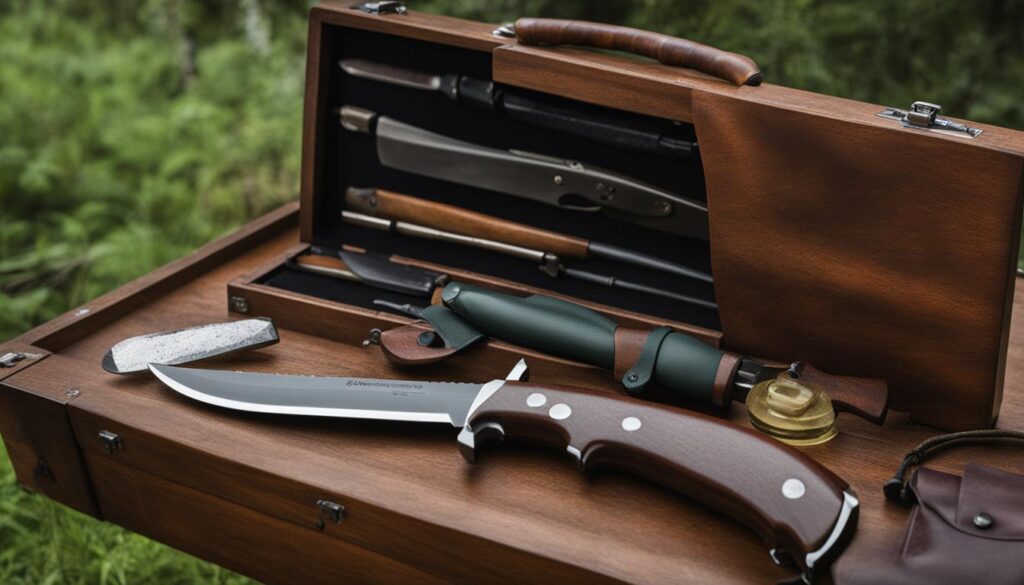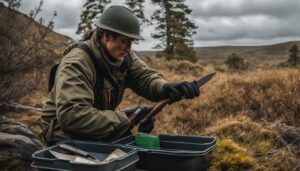When planning a hunting trip, it is crucial to prioritize safety and follow the essential safety rules to ensure a successful and accident-free experience. Handling hunting knives requires special attention and caution. In this section, we will explore the safety guidelines that every hunter should follow while using hunting knives, ensuring a safe and enjoyable hunting trip.
Key Takeaways:
- Always prioritize safety when going on a hunting trip with a hunting knife.
- Follow the essential safety rules to ensure an accident-free experience.
- Properly handle and maintain your hunting knife to enhance performance and longevity.
- Recognize when your knife is dull and learn the techniques to sharpen it effectively in the field.
- Take proper care of your knife by cleaning it and coating it with oil to prevent corrosion.
Taking Care of Your Hunting Knife
Proper maintenance of your hunting knife is essential to ensure its optimal performance and longevity. Neglecting to take care of your blade can result in difficulties during field dressing and butchering, leading to sloppy processing of game meat. In this section, I will discuss the do’s and don’ts of knife care in the field, as shared by Matt Elliott from Benchmade Knife Company during a Montana black bear hunt.
The Do’s and Don’ts of Knife Care
To keep your hunting knife in top condition, it’s important to follow these essential care guidelines:
- Do clean your knife after each use: Use a mild solvent or rinse it clean with water or snow to remove any debris.
- Do coat the blade with oil: After cleaning, apply a thin layer of oil to prevent corrosion. This helps protect the blade’s sharpness and overall quality.
- Don’t use harsh cleaning solutions: Avoid using solvents or chemicals that may damage the knife’s handle or affect its performance.
- Don’t neglect the pivot area: Regularly clean and lubricate the pivot area of your folding knife to ensure smooth opening and closing.
By adhering to these care guidelines, you can maintain the functionality and longevity of your hunting knife.
Field Dressing and Butchering Tips
When it comes to field dressing and butchering game meat, proper care of your hunting knife is crucial. Here are a few tips to ensure a successful and efficient process:
- Keep the blade sharp: A sharp knife allows for clean and precise cuts, making field dressing and butchering easier and more effective. Regularly check the sharpness of your knife and sharpen it as needed using appropriate tools, such as a guided field sharpener.
- Use proper techniques: Learn and practice the correct techniques for field dressing and butchering to minimize waste and maximize the quality of your game meat.
- Take your time: Rushing through the process can lead to mistakes and accidents. Take the necessary time to ensure each cut is deliberate and accurate.
- Keep safety in mind: Always be aware of your surroundings and handle your knife with caution to prevent injuries.
Following these tips will not only help you handle game meat with precision but also maintain the sharpness and condition of your hunting knife.
Table: Recommended Knife Care Products
| Product | Description |
|---|---|
| Benchmade Guided Field Sharpener | An all-in-one sharpening tool designed specifically for field use. It features a diamond-coated rod for honing and a ceramic rod for fine tuning. Compact and lightweight, making it ideal for hunting trips. |
| Mild Solvent | A gentle cleaning solution suitable for removing debris and dirt from your hunting knife without causing any damage or corrosion. |
| Knife Oil | A lubricant specifically formulated for knives, providing corrosion protection and helping to maintain the blade’s performance. |
Remember, proper care and maintenance of your hunting knife are essential for optimal performance, longevity, and the successful processing of game meat. By following these guidelines and using recommended products, you can ensure that your hunting knife remains a reliable and durable tool throughout your hunting adventures.
Recognizing a Dull Knife and Sharpening Techniques
One of the most essential skills every hunter should possess is the ability to recognize when a hunting knife is becoming dull. A dull knife not only hampers the cutting performance but also increases the risk of accidents due to the need for excessive force. To ensure optimal cutting performance and safety, it is crucial to sharpen your knife regularly while on hunting trips. In this section, I will discuss how to recognize a dull knife and share some effective sharpening techniques.
To determine if your knife is dull, you can perform a simple test. Gently run the blade across your thumbnail, keeping it at a slight angle. If the blade fails to catch and slide smoothly along your nail, it is a clear sign that the knife has lost its sharpness. Another way to check is by examining the cut it produces. A sharp knife will effortlessly slice through materials, leaving clean and precise cuts, while a dull blade will struggle, leaving torn or jagged edges.
When it comes to sharpening your hunting knife, there are several tools and techniques available. One highly recommended tool is the Benchmade Guided Field Sharpener, designed specifically for hunting trips. This compact and versatile sharpener comes with different grit surfaces, allowing you to restore your knife’s sharpness quickly and easily. It also features built-in angle guides, ensuring consistent and optimal sharpening results.
Additionally, it is essential to practice proper sharpening techniques. Start by holding the sharpener securely in one hand and the knife blade in the other. Make sure to maintain a consistent angle between the blade and the sharpener, usually between 15 to 20 degrees. Apply gentle pressure and move the blade across the sharpening surface in smooth, controlled strokes. Repeat this process on both sides of the blade until you achieve the desired sharpness.

Table: Common Sharpening Tools
| Tool | Description |
|---|---|
| Whetstone | A traditional sharpening tool consisting of a flat stone or series of stones with different grit levels. |
| Honing Rod | A long, rigid rod made of steel or ceramic used to realign and maintain the edge of the blade. |
| Sharpening System | A complete kit that includes various sharpening tools, such as guided sharpening systems with angle guides and multiple abrasive surfaces. |
| Electric Knife Sharpener | A convenient and quick sharpening option that uses rotating wheels or belts to grind and shape the blade. |
It is important to note that sharpening a knife improperly can damage the blade. Always refer to the manufacturer’s instructions or seek guidance from experienced hunters if you are unsure about the sharpening process. By maintaining sharpness and practicing proper sharpening techniques, you can ensure your hunting knife performs at its best, enhancing your cutting efficiency and overall hunting experience.
Proper Field Care and Storage
After a long day of hunting, it’s important to give your hunting knife the proper care and attention it deserves. By following a few simple steps, you can ensure that your knife remains in excellent condition and ready for your next hunting adventure.
Cleaning
Field care begins with cleaning your knife. Start by removing any debris or residue from the blade and handle. You can use a clump of wet grass or rinse the knife with water or snow to get rid of any dirt or blood. It’s important to remove all traces of moisture to prevent rust from forming.
Coating with Oil
Once your knife is clean and dry, it’s time to protect it from corrosion. Apply a thin layer of oil to the blade, making sure to cover both sides and the cutting edge. This oil acts as a barrier against moisture and helps to maintain the blade’s sharpness. Be sure to use a mild solvent to remove any excess oil before using the knife again.
Sheath
Proper storage is crucial to protect your knife and prevent accidents. Always store your hunting knife in its sheath when not in use. The sheath provides a secure and protective covering for the blade, preventing it from coming into contact with other objects or causing injury. Make sure the sheath is clean and dry before inserting your knife.
| Field Care Steps | Benefits |
|---|---|
| Clean the knife with a clump of wet grass or rinse with water or snow | Removes dirt and debris |
| Apply a thin layer of oil to the blade | Prevents corrosion |
| Store the knife in its sheath | Protects the blade and prevents accidents |
By following these field care and storage practices, you can ensure that your hunting knife remains in excellent condition and ready for action. Taking the time to properly clean, oil, and store your knife will not only extend its lifespan but also enhance its performance when you need it most. Remember, a well-maintained knife is an essential tool for a successful hunting trip.


Knife Safety Guidelines
When it comes to handling a hunting knife, following proper safety guidelines is paramount. By adhering to these guidelines, you can ensure not only your safety but also the longevity and effectiveness of your knife. Here are some essential knife safety rules to keep in mind:
Knife Handling
Always handle your hunting knife with caution and respect. Avoid reckless or careless actions that could result in injury. When using your knife, maintain a secure grip and maintain full control over the blade. Never swing or wave the knife around, and always be mindful of the direction and angle of the blade.
Second Folding Knife or Utility Knife
In addition to your hunting knife, it is wise to carry a second folding knife or a utility knife for tasks that don’t involve field butchering. These versatile tools can come in handy for various purposes such as cutting paracord, preparing meals, or performing other utility tasks. By using a separate knife for non-butcher-related activities, you can prevent unnecessary wear and tear on your hunting knife.
Folding Knife Selection
Choosing the right folding knife is crucial for safe and efficient knife handling. Look for a knife that offers a secure locking mechanism to prevent accidental blade closure. Additionally, consider the size and design of the knife. A compact and ergonomic folding knife, like the Steep Country and Griptilian, provides ease of use and minimizes the risk of slips and mishaps during handling.
| Safety Guidelines | Description |
|---|---|
| Handle with Care | Always handle your hunting knife with caution and respect. Avoid reckless or careless actions that could result in injury. |
| Carry a Second Knife | In addition to your hunting knife, carry a second folding knife or a utility knife for non-butcher related tasks. |
| Choose a Secure Folding Knife | Select a folding knife with a secure locking mechanism to prevent accidental blade closure. |
By following these knife safety guidelines, you can ensure a safe and enjoyable hunting experience while maximizing the efficiency and effectiveness of your hunting knife.
Conclusion
Throughout this article, I have emphasized the importance of prioritizing safety during hunting trips, specifically when it comes to handling hunting knives. By following the essential safety rules and guidelines discussed, hunters can ensure a safe and successful experience in the field.
Proper maintenance and care of hunting knives is crucial to their performance and longevity. By regularly sharpening your knife using the recommended tools and techniques, you can ensure optimal cutting performance when field dressing game. Additionally, taking the time to clean and coat your knife with oil after each use will help prevent corrosion and maintain its functionality.
Knife safety is a critical aspect of hunting trips. Avoiding improper knife handling, such as using the blade for prying actions, can prevent irreversible damage. Carrying a second folding knife or utility knife for non-butchering tasks is also recommended to ensure safe and efficient use.
Remember, hunting trips should be enjoyable and accident-free. By following these safety precautions and guidelines, you can stay sharp and minimize the risk of accidents while hunting. Stay safe, and happy hunting!
FAQ
What are some important safety rules to follow while using hunting knives?
It is crucial to prioritize safety when using hunting knives. Some important safety rules include avoiding prying actions, carrying a second folding knife or utility knife for other tasks, and selecting a suitable folding knife for safe handling.
How should I take care of my hunting knife in the field?
Proper maintenance is essential. Wipe down the knife with wet grass or rinse it clean with water or snow to remove debris. Later, clean it with a mild solvent and coat it with a thin layer of oil to prevent corrosion. Store the knife in its sheath when not in use.
How can I recognize when my hunting knife needs sharpening?
A dull knife will not cut cleanly and quickly through hide and flesh. If you notice difficulty in cutting, it may be time to sharpen your knife. There are different tools and techniques available for sharpening, and the Benchmade Guided Field Sharpener is a recommended option.
What are some tips for safe knife handling?
It is important to avoid using the knife for prying actions that can damage the blade. Carrying a second folding knife or utility knife for tasks other than field butchering is recommended. Choosing a suitable folding knife for safe handling, like the Steep Country and Griptilian, is crucial.





